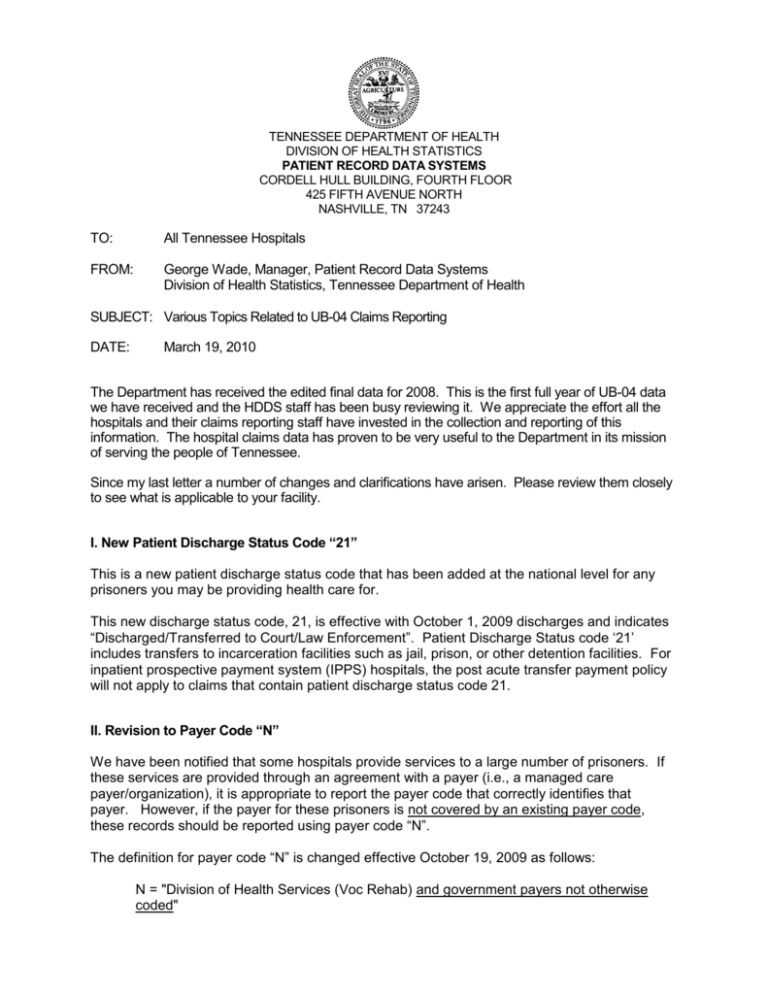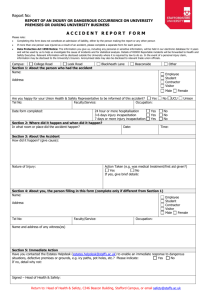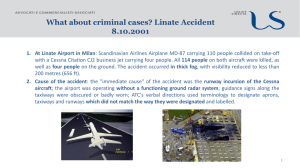SUBJECT: Various Topics Related to UB-04 Claims - THA
advertisement

TENNESSEE DEPARTMENT OF HEALTH DIVISION OF HEALTH STATISTICS PATIENT RECORD DATA SYSTEMS CORDELL HULL BUILDING, FOURTH FLOOR 425 FIFTH AVENUE NORTH NASHVILLE, TN 37243 TO: All Tennessee Hospitals FROM: George Wade, Manager, Patient Record Data Systems Division of Health Statistics, Tennessee Department of Health SUBJECT: Various Topics Related to UB-04 Claims Reporting DATE: March 19, 2010 The Department has received the edited final data for 2008. This is the first full year of UB-04 data we have received and the HDDS staff has been busy reviewing it. We appreciate the effort all the hospitals and their claims reporting staff have invested in the collection and reporting of this information. The hospital claims data has proven to be very useful to the Department in its mission of serving the people of Tennessee. Since my last letter a number of changes and clarifications have arisen. Please review them closely to see what is applicable to your facility. I. New Patient Discharge Status Code “21” This is a new patient discharge status code that has been added at the national level for any prisoners you may be providing health care for. This new discharge status code, 21, is effective with October 1, 2009 discharges and indicates “Discharged/Transferred to Court/Law Enforcement”. Patient Discharge Status code ‘21’ includes transfers to incarceration facilities such as jail, prison, or other detention facilities. For inpatient prospective payment system (IPPS) hospitals, the post acute transfer payment policy will not apply to claims that contain patient discharge status code 21. II. Revision to Payer Code “N” We have been notified that some hospitals provide services to a large number of prisoners. If these services are provided through an agreement with a payer (i.e., a managed care payer/organization), it is appropriate to report the payer code that correctly identifies that payer. However, if the payer for these prisoners is not covered by an existing payer code, these records should be reported using payer code “N”. The definition for payer code “N” is changed effective October 19, 2009 as follows: N = "Division of Health Services (Voc Rehab) and government payers not otherwise coded" Use this payer code when services are provided to prisoners that are not covered by an appropriate payer code. Do not use payer code “O” for services provided to prisoners. The definition of payer code “N” is being revised to help hospitals prevent overuse of payer code “O” (more than 10%). Payer code “N” can also be used in any other situation where the payer is a government agency and the payment is not covered by a specific payer code. For example, one hospital had a group of patients that had been committed, but lacked mental health insurance, and had their payments covered by a grant from the Department of Mental Health. III. Usage of Patient Control Number and Medical Record Number The Patient Control Number (PCN) in pos. 26-50 should always be unique or different for each encounter. This field can be thought of as an invoice number for the service provided on that date. Also, each individual patient should have a Medical Record Number (MRN) assigned to them that stays with them through time. That same number should be reported in pos. 51-75 anytime that patient is seen at the facility. So, the PCN should be unique for each billing and the MRN should be the same on each billing whenever that patient is seen. IV. Use of the HCPCS/Rate/HIPPS Field in Observation Records If outpatient records include revenue code 0760, 0762, or 0769 (observation revenue codes), the information that is reported in the HCPCS/Rate/HIPPS field (Form Locator 44) for this revenue code should be HCPCS information. Do not report the observation room rate for the outpatient observation visit in FL 44. Room rate should be reported in FL 44 only when the record is an inpatient stay and when revenue codes = 010X - 021X. V. Changes to the Point of Origin (Source of Admission) Field as of July 1, 2010 The National Uniform Billing Committee (NUBC) recently approved a series of changes to the Point of Origin code set (formerly “Source of Admission”). These changes become effective for discharges on or after July 1, 2010. This data element is reported in Form Locator 15 of the UB-04 and in CL102/Loop ID 2300 of the 837 Institutional implementation guide. The details of the changes are contained in the NUBC minutes. The changes made primarily affect the following: 1) Three codes are eliminated and will no longer be valid for use: · Code 7 - Emergency Room · Code B - Transfer from Anther Home Health Agency (Replaced with new Condition Code 47) · Code C - Readmission to Same Home Health Agency 2) The definitions to Codes 1 and 2 have been modified. Code 2 now includes both clinic and physician office points of origin. 3) Also effective 7/1/10 is new Condition Code P7 to indicate that the patient was admitted directly from this facility’s Emergency Room/Department; it is FOR PUBLIC HEALTH REPORTING ONLY. If any Condition Code (FL 18-23) has a value of “P7” then report “Y” at position 2272 of the record. Otherwise report “N” in this position. Note that this position 2272 (as well as positions 2273-2274 in section VII) is in a portion of the record layout listed as “State Generated Flags”. These three positions have not been used by the State and should now be used by the hospitals as instructed in this letter. We will send a revised layout to all hospitals reflecting these changes. VI. Unknown Code Values Available for Reporting Accidents The Department of Health has added the following codes to allow for 'unknowns' to be reported in the ACCIDENT CODE, ACCIDENT STATE, and ACCIDENT DATE fields. IF ACCIDENT CODE is 01-05 but ACCIDENT STATE and/or ACCIDENT DATE are unknown: IF the ACCIDENT STATE is unknown, report Accident State as ‘XX’. IF the complete ACCIDENT DATE is unknown, report Accident Date as ‘9999999999’. IF only the accident day is unknown, report the month (01-12) and the 4-digit year and report the day as ‘99’ (i.e., 04992008). IF the accident month and day are unknown, report month and day as ‘9999’ and provide the 4digit year (i.e., 99992008). IF there is an accident but the exact ACCIDENT CODE is unknown (i.e., cannot determine between Accident Code 01 and Accident Code 03), report Accident Code as ‘99’. In these rare cases, the Accident State and Accident Dates should be known. VII. Reporting of Wrong Procedures, Wrong Patients, or Wrong Sites per CMS Instructions CMS has recently promulgated instructions for reporting the performance of wrong procedures, the performance of procedures on the wrong patient, or the performance of procedures at the wrong site. State reporting of this should be according to the following instructions. For inpatient claims both the right claim and the wrong claim should be reported. The right claim should be reported normally. The wrong claim should be reported with the applicable CMS surgical error code put in positions 2273-2274 of the record. The CMS surgical error codes are “MX” for a wrong surgery on the patient, “MY” for surgery on the wrong body part, and “MZ” for surgery on the wrong patient. For outpatient claims only one claim should be reported. To indicate the surgical error the NCD modifier specified by CMS should be reported as a modifier to the appropriate CPT code. These modifiers are “PA” for surgery on the wrong body part, “PB” for surgery on the wrong patient, and “PC” for a wrong surgery on the patient. xc Teresa Hendricks, Director Division of Health Statistics Tennessee Hospital Association Hospital Alliance of Tennessee





